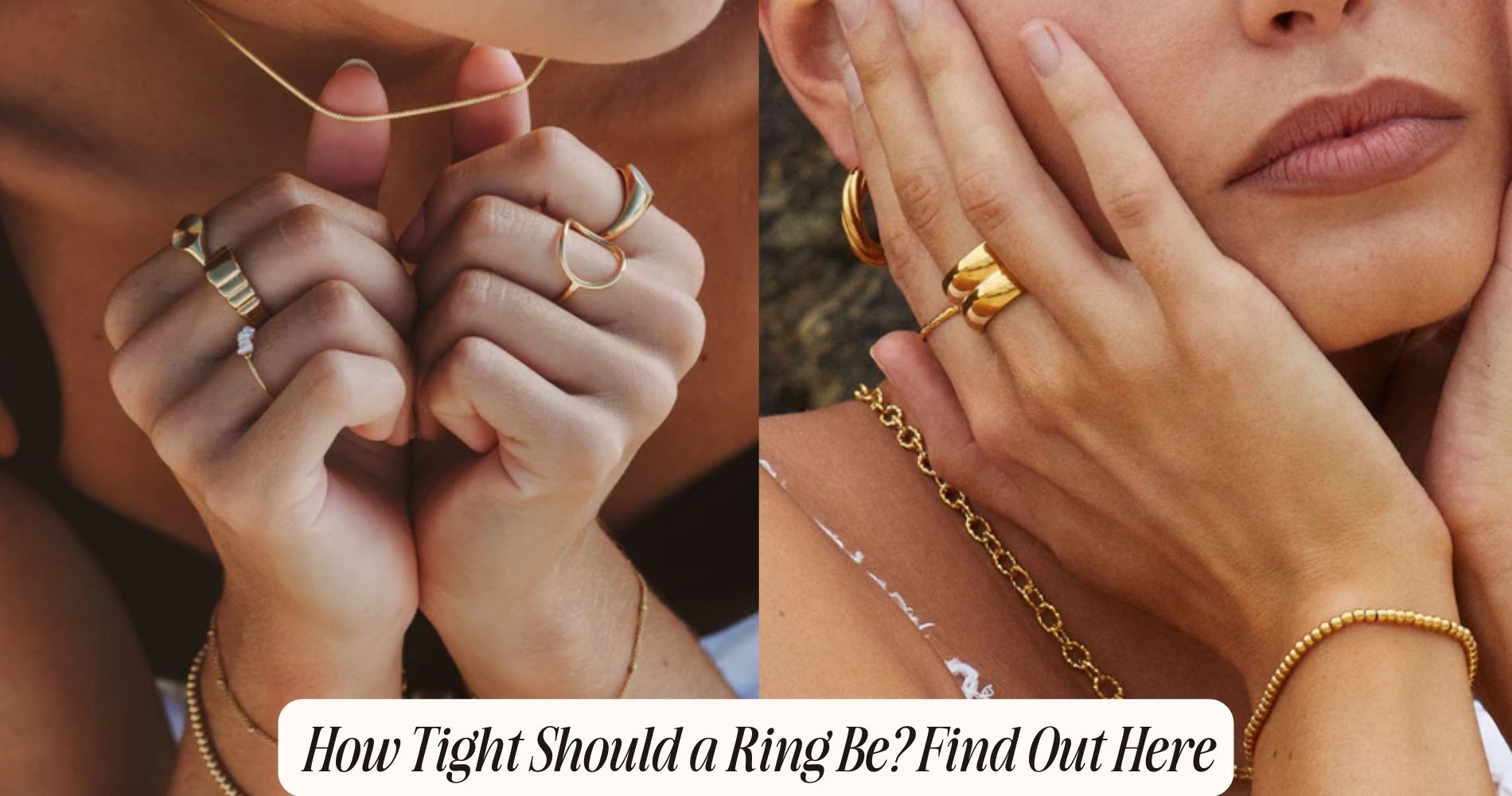
How Tight Should a Ring Be? Find Out Here
Importance of Ring Fit
Guaranteeing a proper ring fit is crucial because a poorly fitting ring can cause discomfort, circulation issues, and even damage to the ring itself. When a ring fits well, it rests comfortably on your finger without slipping off or feeling too tight. Comfort levels are paramount; a ring that's too tight can constrict blood flow, leading to swelling and potential long-term damage. Conversely, a loose ring can easily fall off, posing a risk of loss and potential aesthetic damage from impacts.
For ultimate comfort, a ring should slide over the knuckle with slight resistance and sit snugly at the base of your finger. This balance ensures that the ring remains in place without causing undue pressure. The aesthetic appeal of a ring also hinges on its fit. A well-fitted ring enhances the appearance of your hand, complementing its natural shape and proportions. Additionally, a ring that's too tight or too loose can distort its intended design, diminishing its visual allure.
Measuring Your Finger
Accurate measurement of your finger is crucial for achieving the perfect ring fit. Start by measuring your finger circumference with a flexible measuring tape or a piece of string. Wrap it around the base of your finger, making sure it's snug but not too tight. Mark where the string meets, then measure the length with a ruler. This gives you an accurate finger circumference.
For precision, measure your finger at different times of the day. Your finger size can fluctuate, and measuring multiple times ensures consistency. Avoid measuring when your fingers are too cold or too warm, as this can affect the accuracy.
You can also use a ring sizer, which is a set of metal or plastic rings in various sizes. Slide each ring onto your finger to find the size that fits best. The ring should slide on easily but require a slight tug to remove.
Record your measurements and compare them to a ring size chart. Different regions have different sizing systems, so make sure you're using the correct chart for your area. Accurate measurement of your finger circumference ensures you'll select a ring that's comfortable and secure.
Seasonal Fluctuations
Seasonal fluctuations in temperature can have a significant effect on the size of your fingers, making it important to take these changes into account when determining your ring size. Temperature variations, influenced by climate change, can cause your fingers to swell or shrink.
In warmer months, elevated temperatures lead to increased blood flow, which results in finger swelling. Conversely, colder temperatures in winter cause blood vessels to constrict, reducing finger size.
When you're selecting a ring, it's vital to factor in these seasonal changes to avoid discomfort. A ring that fits perfectly during summer might become too loose in winter, and vice versa.
To guarantee a comfortable fit year-round, measure your finger at different times of the year. Aim for a size that balances these variations—slightly snug in the summer, yet not overly loose in winter.
Climate change also exacerbates temperature extremes, making it even more important to take into account these shifts. By understanding how temperature variations affect your finger size, you'll be better equipped to choose a ring that maintains a consistent fit throughout the year, ensuring both comfort and security.
Ring Material Matters
Selecting the appropriate ring material is essential because different metals and materials can greatly impact the fit and comfort of your ring.
First, consider material durability. Rings made from durable metals like platinum or tungsten are less likely to deform under pressure, ensuring a consistent fit over time. However, these materials lack metal flexibility, making them more challenging to resize.
If you're looking for a ring that can adapt to slight size changes, precious metals like gold or silver offer more flexibility. These metals can be resized more easily, accommodating any minor adjustments needed for a perfect fit.
Next, think about how the ring material interacts with your skin. Some materials, such as titanium, are hypoallergenic and reduce the risk of skin irritation. Knowing your skin's sensitivity helps in selecting a material that maintains comfort without compromising durability.
Lastly, consider the wear and tear your ring will undergo. If you lead an active lifestyle, a more durable material will withstand daily activities better. Conversely, if your ring is more of a statement piece worn occasionally, the flexibility of softer metals might suit you better.
Your choice of material is vital for ensuring both long-term comfort and fit.
Checking for Proper Fit
Guaranteeing your ring fits properly involves checking specific indicators that signal both comfort and security. First, look for skin impressions. When you remove the ring, it's normal to see a slight indentation on your skin, but deep marks or significant redness indicate the ring is too tight.
On the flip side, if the ring slides off too easily, especially when your hand is at rest, it's too loose.
Next, assess the comfort level. A perfectly fitting ring should feel snug but not restrictive. You should be able to twist the ring around your finger with minimal resistance, but it shouldn't spin freely. Try clenching and unclenching your hand; the ring should remain comfortably in place without pinching. Additionally, consider the knuckle test: the ring should slide over your knuckle with a bit of effort but not cause discomfort.
Lastly, observe how the ring feels throughout the day. Finger size can fluctuate due to temperature, activity, and hydration. If the ring remains comfortable and secure during these variations, you've likely found an excellent fit.
Adjusting Ring Size
Adjusting ring size involves precise techniques to either enlarge or reduce the circumference for a perfect fit. When considering DIY resizing, you can use tools like a ring mandrel and mallet for minor adjustments. Slide the ring onto the mandrel and gently tap to increase the size.
For temporary adjustments, silicone ring guards or sizing beads can be applied inside the band to reduce the internal diameter.
For a more permanent solution, professional resizing is recommended. Jewelers can cut and solder the band to enlarge or reduce its size without compromising the ring's structural integrity. They often use specialized tools like ring stretchers for enlargement or remove a small section of the band for reduction, followed by precise soldering.
When resizing, consider the material and design of your ring. Metals like gold and platinum are easier to adjust than tungsten or titanium. Intricate designs require meticulous care to avoid damage.
Always measure your finger size accurately to guarantee the best fit. Temporary adjustments are ideal if you're unsure about permanent changes or expect fluctuations in finger size due to temperature or other factors.
Signs of a Tight Ring
When resizing your ring, it's important to recognize the signs of a tight fit, which can include discomfort, restricted blood flow, and visible indentations on your skin. A properly fitting ring should slide on easily and come off with a bit of resistance. If you experience difficulty removing the ring, it may indicate circulation issues.
Skin indentations are one of the most noticeable signs. If you see deep marks on your finger after removing the ring, it's too tight. This persistent pressure can hinder proper blood flow, leading to circulation issues. You might feel a tingling sensation or numbness in your finger, both of which are red flags.
Another sign is swelling. When a ring is too tight, it can cause your finger to swell, exacerbating the problem. You should also watch for any changes in skin color, such as redness or a bluish tint, which indicate restricted blood flow. In extreme cases, a tight ring can cause pain or even damage the skin.
Paying attention to these signs can help you determine if your ring needs adjustment, ensuring both comfort and safety for daily wear.
Risks of a Loose Ring
A loose ring can pose significant risks, such as slipping off unnoticed and becoming lost, or causing accidents if it catches on objects. When your ring isn't snug on your finger, the chances of ring loss increase dramatically. Everyday activities, like washing your hands or handling objects, can cause the ring to slide off without you realizing it. This not only results in financial loss but also the emotional distress of losing a sentimental item.
Moreover, a loose ring can become a safety hazard. If it catches on machinery or other objects, it could lead to injuries. This is particularly concerning in work environments where manual labor is involved.
Additionally, a loose ring may exacerbate finger swelling. If your fingers swell due to temperature changes or physical activity, the ring might press unevenly against your skin, causing discomfort or even minor injuries.
To prevent these issues, ensuring your ring fits correctly is essential. A well-fitted ring will stay securely in place, reducing the risk of loss and injury. Regularly checking the fit of your ring, especially if you notice any changes in your finger size, will help maintain both safety and comfort.
Professional Resizing Tips
To guarantee your ring fits perfectly, consider consulting a professional jeweler who can expertly resize it to match your exact finger dimensions. A jeweler consultation ensures the ring fits snugly without compromising comfort or circulation.
During the consultation, the jeweler will use specialized sizing tools, such as ring mandrels and finger-sizing gauges, to determine your precise ring size. These tools provide accurate measurements, capturing even minor variations in finger size.
Jeweler consultations are vital because they take into account factors like knuckle size and temperature fluctuations, which can affect finger dimensions throughout the day.
Once the correct size is determined, the jeweler will proceed with the resizing process. This can involve either adding or removing metal from the ring band. For intricate designs or rings with gemstones, precision is essential to maintain the ring's integrity and aesthetic appeal.
Professional jewelers have the expertise to make these adjustments seamlessly, ensuring the ring retains its original beauty.
Long-Term Ring Care
After achieving the perfect fit through professional resizing, maintaining your ring's condition over time requires consistent and mindful care practices. First, establish a regular cleaning routine. Depending on the metal and gemstones, you may need specialized cleaning agents. For common metals like gold or silver, a mild soap with warm water and a soft-bristled toothbrush can be effective. Avoid abrasive cleaners that can damage the ring's surface.
Next, consider your storage solutions. When not wearing your ring, store it in a fabric-lined jewelry box or a soft pouch to prevent scratches and tarnishing. If your ring includes delicate gemstones, make sure it's stored separately to avoid contact with other jewelry that could cause chipping or scratches.
Also, be mindful of environmental factors. Remove your ring when engaging in activities involving harsh chemicals, such as cleaning or swimming in chlorinated pools, as these can deteriorate the metal and gemstones.
Regularly inspect your ring for loose stones or signs of wear and tear, addressing issues promptly to avoid further damage.
Conclusion
Ensuring your ring fits correctly is essential for comfort and safety. Measure your finger accurately, considering seasonal fluctuations.
Remember, different materials can affect fit. Check for proper fit by ensuring it slides smoothly but resists slightly at the knuckle. Watch for signs of tightness like redness or discomfort, and avoid risks associated with a loose ring.
Consult a professional for resizing, and practice long-term care to maintain the best fit and condition.
























Leave a comment
This site is protected by hCaptcha and the hCaptcha Privacy Policy and Terms of Service apply.